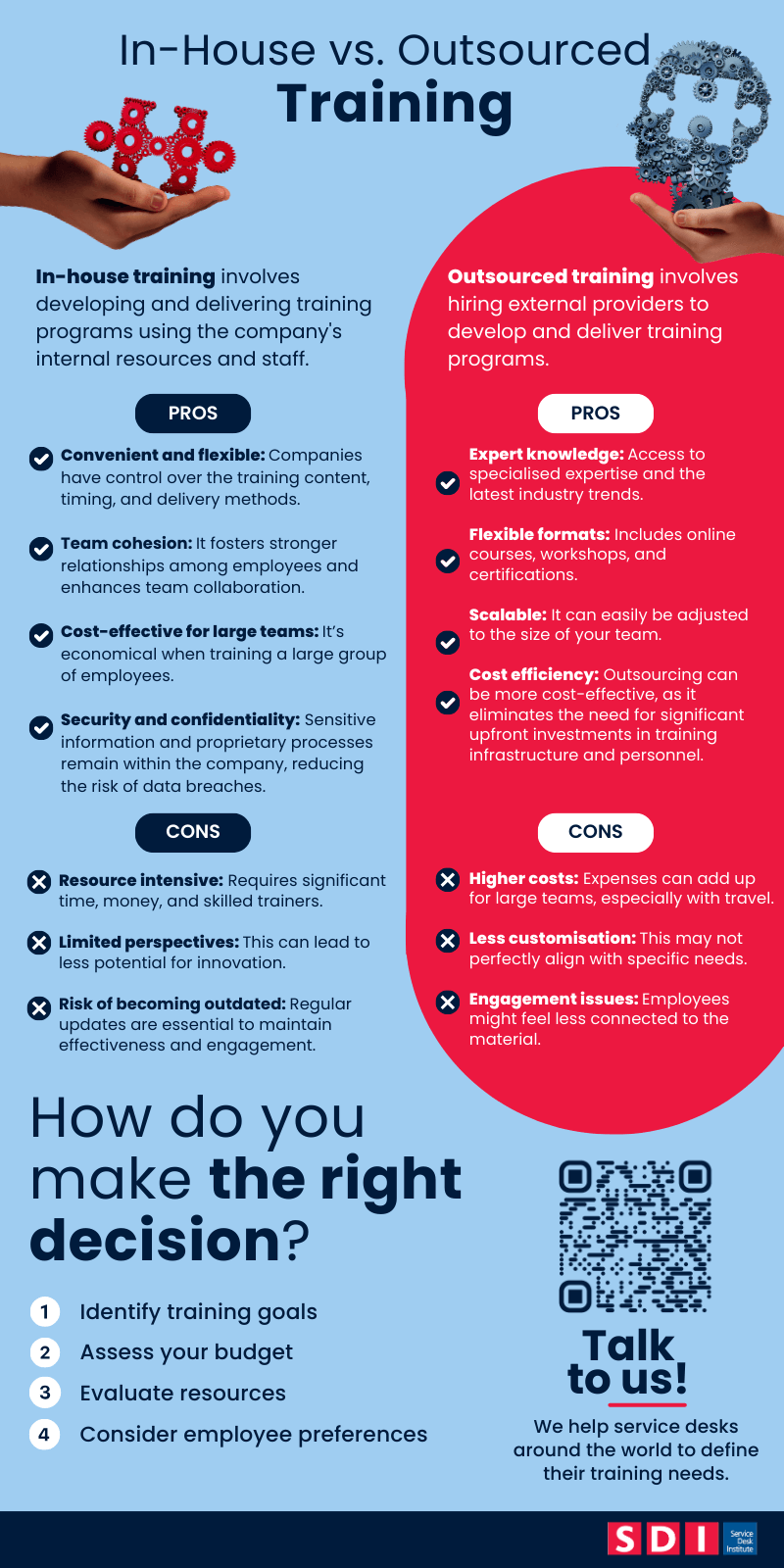 Back to Resources
Back to Resources
A survey by LinkedIn Learning revealed that 68% of IT professionals prefer training that includes a mix of in-house and outsourced approaches, as it offers both relevance and industry-wide perspectives. But choosing between in-house and outsourced training can be challenging. Both have their own benefits and drawbacks.
In this blog, we’ll do a straightforward comparison to help you decide which is best for your team.
What are the benefits of in-house training?
Before we discuss the benefits and disadvantages of this training method, let’s define in-house training. Simply put, in-house training involves developing and delivering training programs using the company’s internal resources and staff.
This approach allows for a high degree of customisation and alignment with the company’s specific needs and culture, which is one of the reasons why it is a very popular choice for many organisations.
Here are some benefits of in-house training:
✅ Convenient and flexible training programmes
With in-house training, you have control over the training content, timing, and delivery methods. This means that in-house training can be customised to address your specific needs. For instance, if your service desk team needs to improve their IT support skills, you can design a program that focuses on your systems and processes.
It’s a very convenient option as the training takes place at your location, reducing travel time and costs. This also makes scheduling easier and ensures minimal disruption to daily operations.
✅ Good for enhancing team collaboration
In-house training is good for organisations that are aiming to foster stronger relationships among employees and enhance team collaboration.
✅ Cost-effective for large teams
This type of training is very economical when it comes to training a large group of employees. If you have a large team, the cost per person can be lower than outsourced training. The initial setup might be pricey, but the overall expense decreases as more employees participate.
✅ High security and confidentiality
In-house training reduces the risk of data breaches and helps to keep important information in the company, which is important—especially for industries with strict data security requirements.
The challenges of in-house training:
❌ Resource intensive
Developing in-house training programs requires significant time, money, and skilled trainers. While this might not be an issue for large organisations, small businesses might find it difficult to allocate these resources effectively.
❌ Limited perspectives
Internal trainers might not always be as up to date with industry trends and insights as external experts, which can limit the breadth and depth of knowledge your team receives. It can also potentially stifle creativity and innovation.
❌ Risk of becoming outdated
Regular updates are crucial for keeping in-house training programs relevant and engaging. Without them, these programs can become outdated, impacting their effectiveness and the level of employee engagement.

What are the benefits of outsourced training?
When comparing in-house training with outsourced training, it’s important to note that outsourced training involves hiring external providers to design and execute training programs. By choosing this approach, organisations can gain access to specialised knowledge, skills, and resources that may not be readily available internally.
As a result, this can lead to the development of high-quality training programs tailored to specific needs. It’s also good for incorporating the latest industry best practices and expertise.
Let’s look at some benefits of outsourced training:
✅ Access to expert knowledge
External trainers bring specialised expertise and fresh perspectives. They stay updated with the latest industry trends and technologies, offering your team valuable insights.
✅ Flexible training formats
Outsourced training comes in various formats, such as online courses and workshops. Employees can choose the format that best fits their schedules and learning preferences.
✅ Cost-efficient and scalable
Outsourcing can be more cost-effective, as it eliminates the need for significant upfront investments in training infrastructure and personnel. These programs can easily adjust to the size of your team, whether you’re training a few individuals or an entire department.
Here are some challenges of this approach:
❌ Higher costs for large teams
While it can be affordable for small groups, the cost of outsourced training can add up for larger teams, especially if travel and accommodation are needed.
❌ Less customisation
External programs might not align perfectly with your specific needs. While some customisation is possible, it might not be as completely tailored as in-house training.
❌ Possible engagement issues
Employees might not feel as connected to outsourced training programs, especially if parts of the content isn’t directly applicable to their roles.
❌ Onboarding time required
External trainers may need time to understand the company’s specific needs and culture, which could potentially cause delays in executing training programs.
Which training programme is best for your organisation?
With in-house training, you can develop a program that focuses specifically on your company’s support system, customer interaction protocols, and internal software tools. This ensures that the training is highly relevant and immediately applicable.
On the other hand, if you opt for outsourced training, you could choose a course that offers a broader view of customer service best practices. This might introduce your team to new techniques and tools that they wouldn’t encounter in an in-house program.
⚡ Here are a few tips to help you decide:
🔹Identify training goals to determine what you want to achieve.
🔹 Consider your financial resources. In-house training requires an upfront investment but can be more cost-effective for larger teams. Outsourced training is more flexible but might be pricier per participant.
🔹 Look at the resources you already have available. If you have skilled trainers and the time to develop a training program, in-house training might be the right choice. If not, outsourcing might be the better option.
🔹 Consider how your employees prefer to learn. A mix of in-house and outsourced training might be the best approach to keeping everyone engaged and continuously improving.
So, in conclusion, here’s when to opt for one instead of the other:
⚡ Choose in-house training when:
🔹 You need highly customised training aligned with specific internal processes, or you need to address very specific issues.
🔹 You have the resources to develop and maintain training programs.
🔹 You have long-term training objectives, and continuous training is required.
⚡ Choose outsourced training when:
🔹 You have a need for general skill development or training on new or specialised topics that require external expertise.
🔹 You need to quickly scale training across multiple locations or a large workforce.
🔹 Your organisation wants to focus internal resources on core business activities.
Do you want to maximise learning with minimal disruption?
At SDI, we understand the importance of effective training without disrupting your day-to-day work.
That’s why we offer bespoke training solutions, both virtually and face-to-face, that are customised to meet your team’s specific needs.
We can bring expert trainers to your doorstep, saving you time and money. If you are all about making the learning experience seamless and valuable, we can help your team grow and succeed in the way that works for them.



















